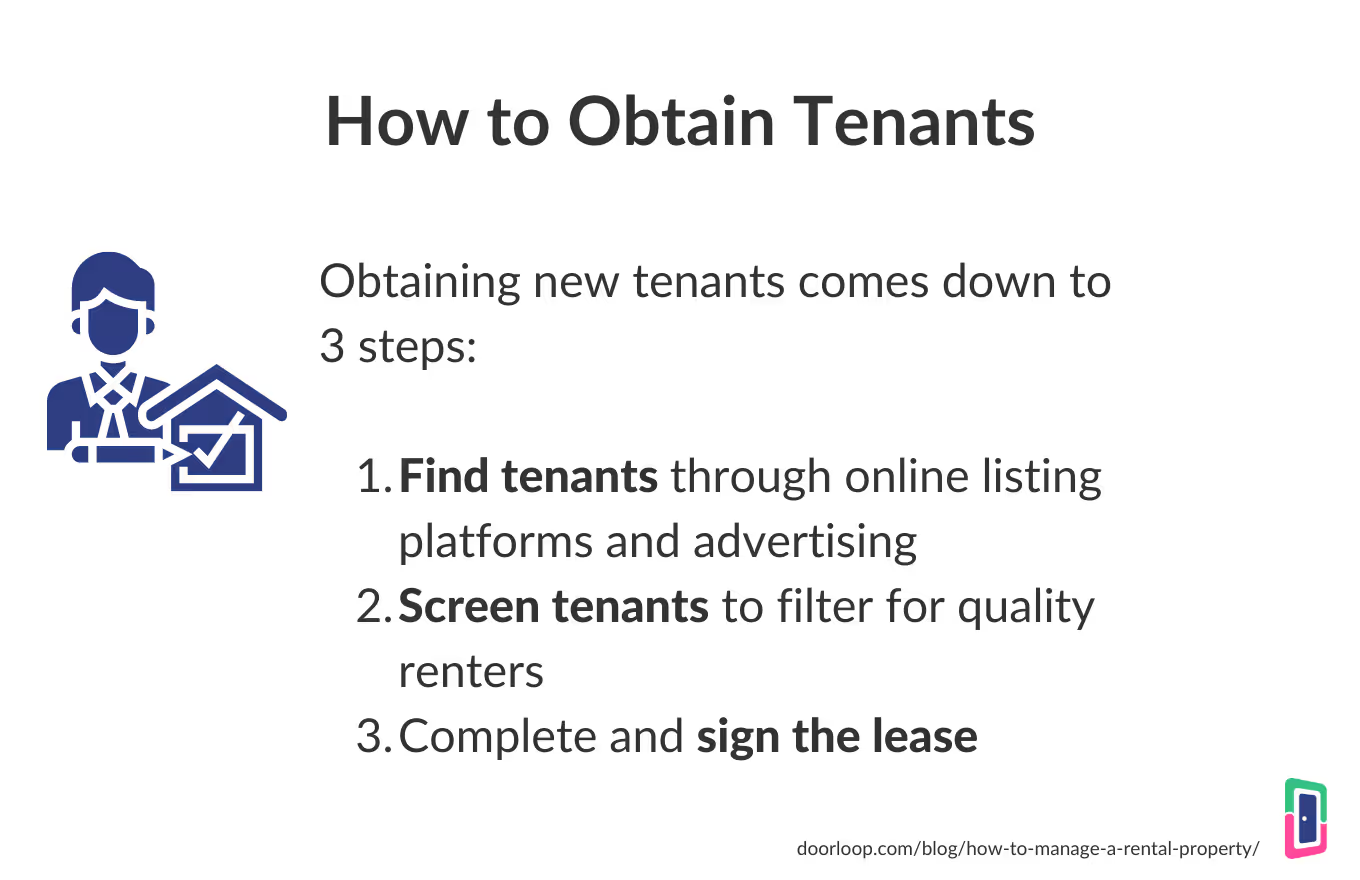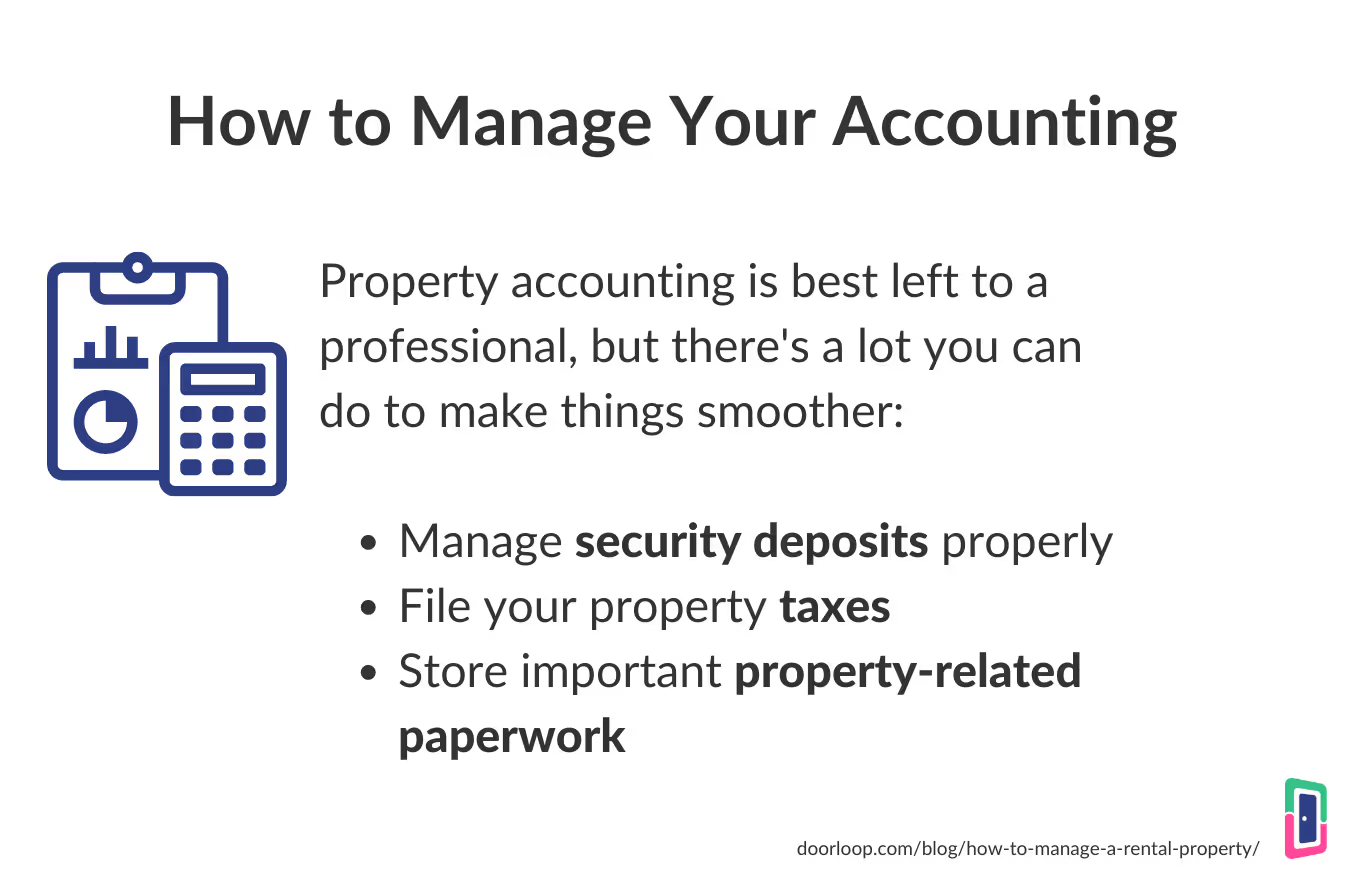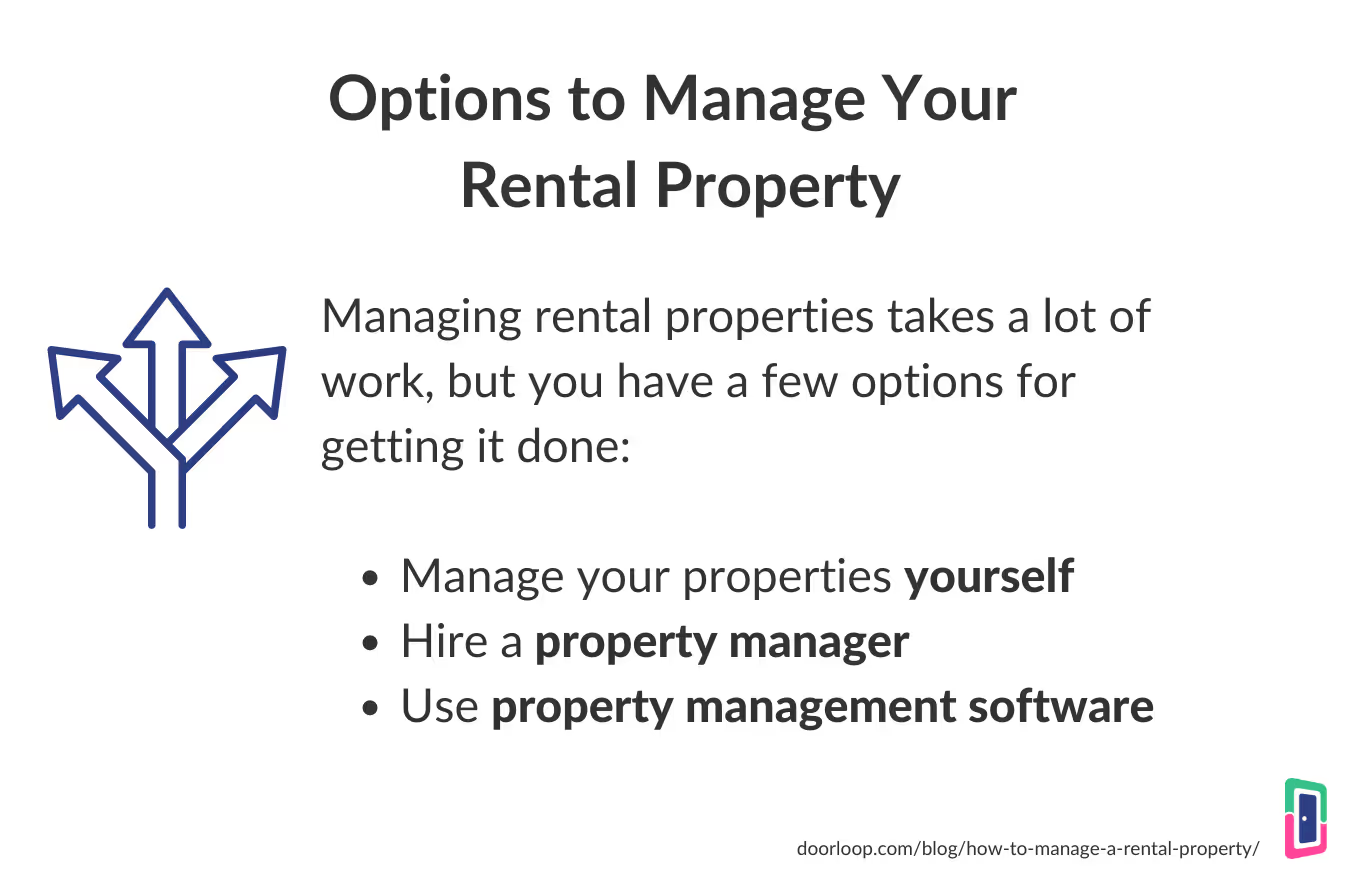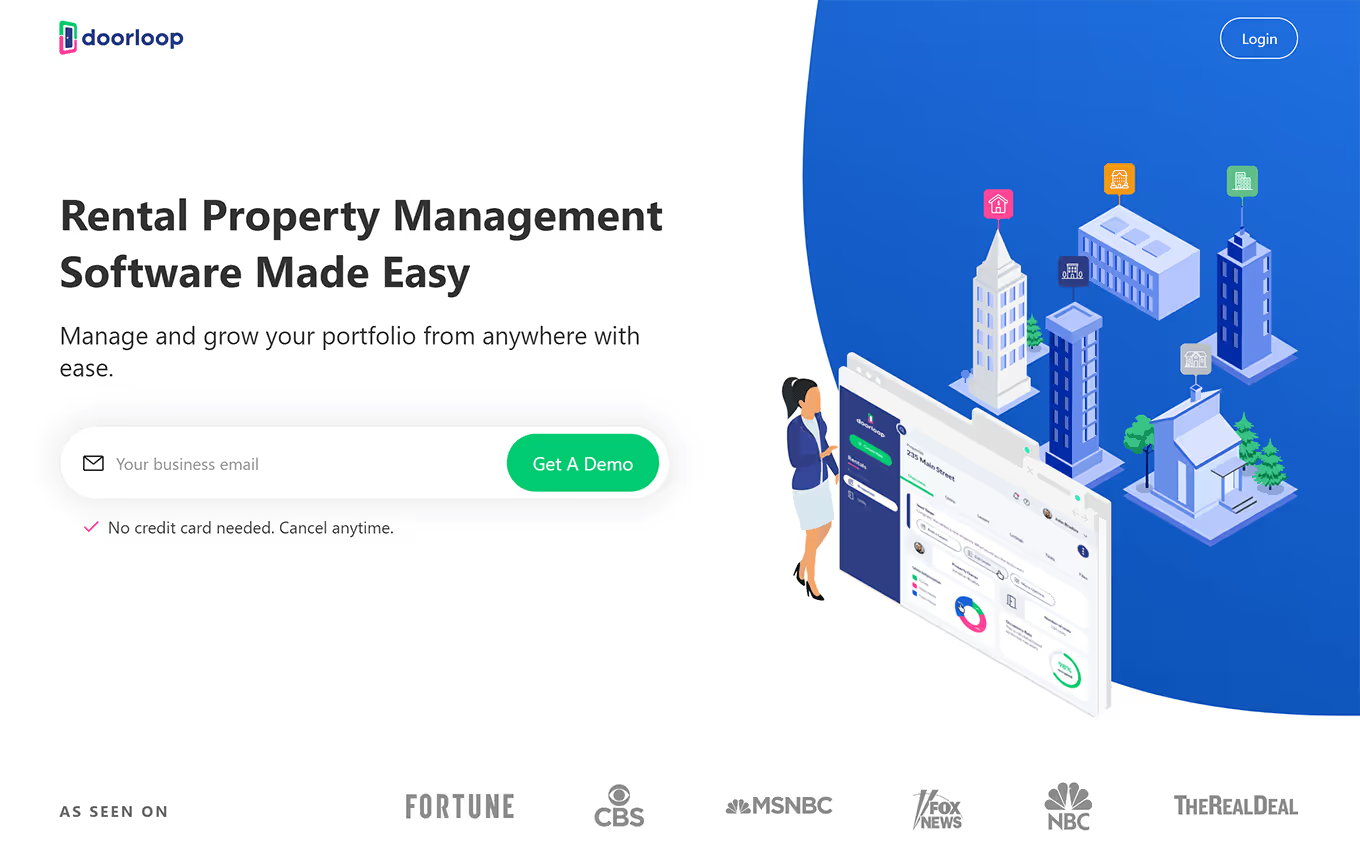You can manage your own rental property and achieve success!
With that said, it’s difficult without a plan in place that helps you optimize how you manage every area.
That’s especially true with multiple properties when things really get difficult.
To manage your own rental properties, you’ll not only want a plan in place for each area of property management, you should also consider using a tool like property management software that helps bring it all together, streamlining and optimizing where possible.
First, let’s talk about the full picture.

What is involved in managing rental properties?
Whether you’re interested in:
- Managing your rental property on your own, or
- You’re a property manager taking on your first property and looking to optimize your process
The property management side of things is the same.
There are essentially 4 main areas of property management:
- Obtaining tenants
- Manage those tenants
- Managing the property itself (i.e. maintenance and repairs)
- And handling your property accounting (and other paperwork)
Below, we’ll be covering each of those areas in detail.
By the end, every piece of the puzzle that is rental property management should be clear.
First, let’s start with the very beginning of the process: obtaining tenants.

Part I: How to obtain tenants
First, let’s talk about getting tenants.
After all, this whole process is pointless if you can’t fill your units!
In this section, we’ll cover:
- Finding tenants
- Screening tenants
- And completing the lease
1. Find tenants
First, let’s go find some tenants.
There are a few ways to go about that and steps to keep in mind:
Add and update your property’s listing on listing platforms
Property listing platforms like Zillow and Redfin are a great way to get free exposure.
Make sure your property is listed on every major platform as well as that the property’s information is correct and photos are updated.
Advertise on those platforms
Marketing your property online through ads on said listing platforms is a good way to get additional exposure above what other competing properties are getting in your area.
Host an open house
Good ol’ fashion never goes out of style, and no matter how digital we become, you need to host open houses to convert most tenants to apply.
Allow leads to apply online
Despite the above, you still want to allow prospective tenants to apply online to make it as easy as possible to apply.
2. Screen tenants
Once you have applications coming in, it’s time to make sure you’re letting the right tenants in that are likely to:
- Pay rent (kind of important)
- Take care of the unit
- And be generally reliable in terms of their responsibilities
It’s a great feeling to be able to offer amazing, safe, and comfortable homes to families and individuals.
However… real estate is business, and you need to have a reliable system for making sure prospective tenants are going to be reliable.
Screening can be a bit of a pain without some assistance– it typically includes running a background check and credit check, depending on your preference– which is why we suggest using property management software (like DoorLoop).
That’s because it can screen your tenants right from within the app, greatly simplifying the process.
3. Complete the lease
Once you’ve screened the tenant, it’s time to complete paperwork and get the lease signed.
Finalizing the agreement isn’t the first step however. First, you need to draft your lease and run it by a legal expert who can advise you on whether you need to change anything or not.
It’s vital to make sure that you’re not only covering yourself but also that you’re providing every right owed to the signee and tenant, such as fair housing laws.
Once you’ve done that, the process for signing each lease will be:
- Review the lease with your tenant
- Sign and complete the lease
- And make sure both you and your tenant receive a copy of the completed agreement

Part II: How to manage your tenants
Now that you’ve got your first tenant– or tenants– in, let’s talk about your responsibilities as a landlord.
Managing tenants can be the toughest part of the job, as you’re working with people as it pertains to their home.
This section deals with:
- Establishing a safe and healthy living environment
- Rent collection
- Tenant communication
- And maintenance requests
1. Establish a safe and healthy living environment
The title says it all: this is about making tenants feel taken care of while making sure to cover your bases in terms of proper safety measures.
It includes a number of things, including:
- Changing locks each time a new tenant moves in
- The property is clean and safe to live in regarding health, i.e. safe from bugs, rodents, mold, lead-based paint)
- The water heater is working properly so they have both heat throughout their home and hot water
- Both smoke and CO2 detectors have been tested and are working properly (and there is one located on each level of the property and near each bedroom)
- The necessary safety equipment is on-hand such as fire extinguishers
- Also, make sure to give ample notice to tenants when taking certain actions such as when you need to enter the property for maintenance, you’re doing your annual or bi-annual inspection, or pursuing an eviction.
2. Rent collection
Next, this point is obviously vital to the success of your rental property as a business.
There are two important things to cover here:
- Give your tenants a simple, easy, and convenient way to pay rent
- And have a way of sending effective payment reminders
Both are easily handled with property management software, which can offer both a tenant portal where tenants can pay rent and check their payment history as well as giving you the ability to post and send late payment reminders.
3. Tenant communication
Proper communication is key to maintaining a good relationship with your tenants.
It’s all too easy to “set it and forget it” so to speak, setting up tenants in their unit and then sitting back and collecting rent.
But, the reality is, you need to maintain regular communication with each of your tenants. Not only to catch potential maintenance issues that they may have forgotten to mention (so you can fix them before they become a bigger issue) but also just so that they know you care.
If your tenants feel taken care of, they’ll be happier in your property. And the happier they are, generally the better tenant they’ll be and the longer they’ll stay.
4. Maintenance requests
We won’t dive deep into this part yet (see the next section), but it’s important to include here as well.
That’s because handling maintenance requests is a big part of being a good landlord to your tenants and keeping them happy.
When maintenance requests are received, make sure to respond to them promptly and take care of the issue as soon as possible.
Also, to continue off of the last point, make sure to communicate clearly with your tenants throughout the entire process.
If you need to enter the property, make sure to contact them ahead of time to get their permission and let them know when they should be expecting a repairman.

Part III: How to handle your property maintenance
Now that you know what you’re doing with your tenants, let’s talk about how to handle the property.
By that we really just mean handling your property maintenance and repairs, the physical upkeep of the property itself.
This is twofold:
- Handling maintenance requests from tenants
- And regular property repairs and maintenance
Both are important not only for keeping your current tenants happy and new tenants coming in (as existing tenants affect your property’s ratings and reviews), it also helps:
- Maintain your property’s value, and
- Saves you money on larger repair issues that can happy when you don’t keep up with regular maintenance
1. Take care of maintenance requests from tenants
First, it’s important to handle maintenance requests from tenants as soon as possible.
That’s typically:
- Water leaks and toilet issues
- Electrical malfunctions
- Water heater or furnace problems
- Gas leaks
- Etc.
Make sure your tenants have an easy way of getting a hold of you when they have maintenance issues to reduce the chance that they do a custom patch-up job or ignore the issue and forget to mention anything.
They might decide it’s not a big deal or forget to mention anything, but it could end up costing you big time if more time goes by and the issue becomes worse.
Property management software can allow you to offer a portal where tenants can send in maintenance requests through an app on their smartphone, reducing as much friction as possible.
2. Stay on top of regular property maintenance and repairs
In addition to maintenance requests, it’s vital to perform regular maintenance on the property to keep in good shape. It’s also important to perform the necessary repairs when something breaks.
This most notably includes both an annual inspection of the entire property and seasonal inspections for weather-based issues.
Annual inspections
For your annual inspections, you’ll want to check everything including in each unit and every major system on the property. That includes:
- Checking safety detectors and other equipment such as fire extinguishers
- Checking and flushing water heaters
- Inspecting restrooms and kitchens for mold and grout buildup
- Changing filters
- Looking for signs of pests
Seasonal inspections
Depending on your location, this may or may not be necessary. This can include:
- Pre-season inspection to make sure water heaters and ACs are working properly
- Postseason inspection to look things like water damage during rainy seasons and roof damage during heavy winds or hail
Check out our apartment maintenance checklist and download a copy (free) before your next inspection.

Part IV: How to manage your accounting (and other paperwork)
Let’s move beyond the physical now into the paperwork (hurray…).
We know, it’s not exciting. But it is one of the most important things to take care of when it comes to managing your rental property.
We talked about collecting rent already under how to manage your tenants, so we won’t cover that here.
Instead, we’ll focus on the bookkeeping and keeping track of all related property paperwork.
1. Manage security deposits
You’re required to handle security deposits in a specific way, so it’s important to make sure you have what you need set up to do that.
To make sure you’re managing your security deposits properly:
- Follow all state-wide property deposit regulations
- Keep deposits in a separate account
- And, when it comes to paying security deposits out, remember to account for all damages
2. File taxes
No one likes talking about taxes, but it’s a necessary chore if you own or manage property.
Property taxes can get a bit more complicated than your average business taxes, however.
There are a few reasons for that, from different types of income (rent and advanced rent, for example) to a greater diversity of expenses.
Here are some of the most common rental property expenses you’ll need to report on your taxes:
- Maintenance and repairs
- Marketing and advertising
- Property utilities (water, trash, gas, electric)
- Property taxes
- Insurance
- Attorney fees
It’s best to default to the knowledge and expertise of a professional accountant here.
However, if you just have one or a few properties, there are some accounting softwares that allow you to file your business and personal taxes simultaneously.
3. Store important property-related documents somewhere safe
This doesn’t just have to do with accounting-related documents, but it can.
There are several types of documents, each which you should keep a copy of at all times in the event that you may need it.
That can include copies of:
- Rent receipts
- Rental applications
- Lease agreements
- Inspection reports
- Proof of insurance
Preferably, you keep both a digital and paper copy of each of the above, just to give yourself a little extra insurance to make sure you never lose a copy of everything no matter what happens.

Options to manage your rental property
Now that we’ve covered the 10,000-foot view of everything you need to know to manage your rental property, let’s talk about your options for getting that done.
There are a few ways you can go about getting all these things taken care of:
1. Self-management
First, you can choose to manage your rental properties yourself.
This is best done when you have between one and a few properties, as it’s still somewhat doable to manage the needs of each property sufficiently.
However, if you have more than a handful of properties, you’ll want to look into at least getting property management software or hiring a property management company.
2. Property management
Property managers are professionals who are experts in managing properties, so you can trust a good one will take care of your property.
However, you need to do the work to find one you feel fits your needs, as not every property management company offers the same services.
Some will manage your entire property including everything from accounting to maintenance and repairs and tenant management.
Alternatively, many property management companies specialize in one or a few services.
So, if you’d prefer to handle the accounting for your properties but you need help with maintenance and repairs, you can hire a property management company to just take care of that.
3. Property management software
This is less a new option and more something that can help any kind of property management easier, which makes it all the more important to mention.
Whether you’re managing your properties on your own or you’re a property manager looking to streamline your operation, property management software can do a lot to make managing your properties easier.
For example, with DoorLoop’s all-in-one property management software, you can get access to:
- A suite of accounting features designed for property accounting
- A full maintenance management system
- Tenant communications features that allow you to streamline communication
- Rent collection tools such as automatic rent payments and a convenient tenant portal that allows tenants to keep tabs of rent due and other responsibilities
- eLeasing tools that made the entire leasing process easier, such as screening tools and online applications
- Marketing tools such as automatic listings and a custom IDX-based website
- Owner portal for property managers where you can print checks and even run key reports to keep your owners happy
So, whether you’re an owner or property manager, property management software can completely change how you manage your portfolio.

Schedule a free demo to see how DoorLoop can help you.
Frequently asked questions
How do I manage multiple rental properties at once?
Managing multiple properties can be overwhelming, especially if you’re doing it yourself. To effectively manage multiple properties:
- Hire a property manager (or property management company), or
- Use property management software to streamline property management tasks like accounting, maintenance, and tenant communications.
How do you manage finances for a rental property?
Property management accounting can be tricky, as typical accounting software isn’t designed for the unique needs of property accounting.
For example, with QuickBooks, you can’t create properties or tenants, causing you to create workarounds with the ‘Customers’ class and subclass.
To more effectively manage your property accounting, consider using property management accounting software designed to manage the accounting for your entire portfolio.
































.svg)
.svg)

